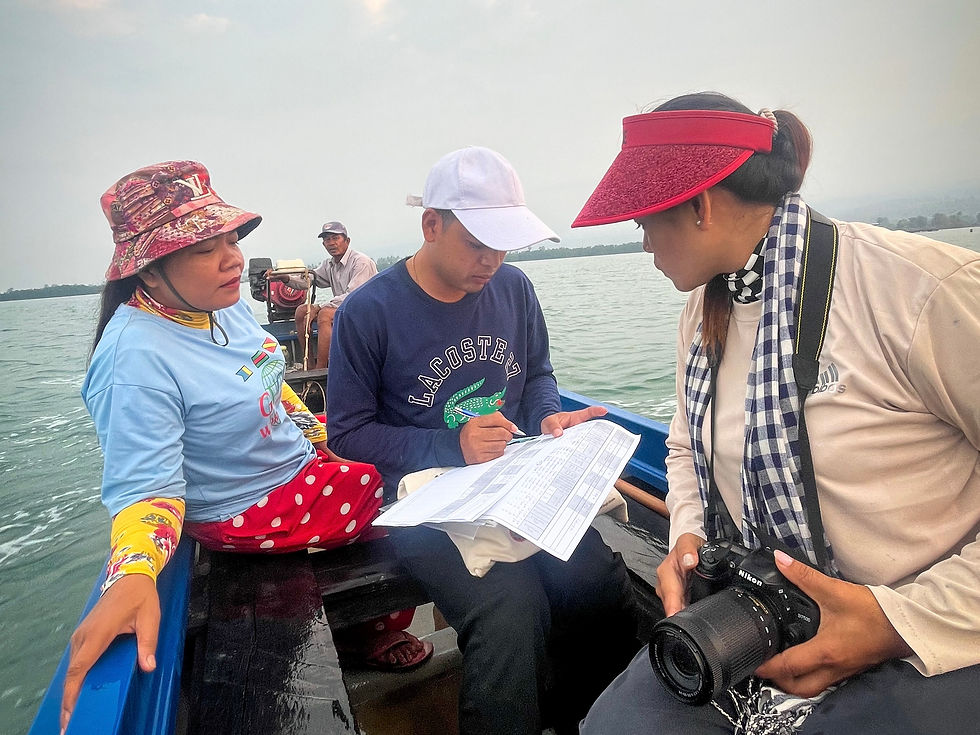Breathing With Dolphins: A Cambodian Marine Conservationist’s Journey from Awe to Action
- Sopheanie Phion

- Aug 25
- 3 min read

When a dolphin surfaced beside her boat and exhaled softly, it changed everything for Sopheanie PHION. In this personal story, the young researcher shares how science, community, and heart come together to protect endangered marine mammals in the waters of Cambodia. This is a story of ocean love, leadership, and hope.
The Moment That Changed Everything
“The first time I heard a dolphin breathe, I was so emotional. It was as if the ocean itself had whispered, ‘You belong here.’”
I was standing on a research boat off the coast of Kep Province, the sun soft against my skin and the sea calm, almost sacred. That’s when I heard it, a deep, slow exhale from just beneath the surface. A dolphin had surfaced next to us. And then another. And another.
Their breaths sounded like sighs, like ancient stories. In that moment, something inside me shifted. That breath echoed into the depths of my soul and never left. It became the reason I chose this path.
Before that day, I didn’t know I was meant to live a life with the ocean. I didn’t know the sea would become my home, that dolphins would become my family, and that every breath they took would remind me to keep going, especially on the hard days.

A Journey of Unexpected Belonging
Growing up, I knew there were women working to protect the ocean—but they weren’t always visible in my world. Marine science felt distant, and ocean conservation wasn’t something we talked about much. It took time for me to realize that I could be part of that change too.
But that first dolphin sighting? It changed everything. I joined a field survey with Marine Conservation Cambodia (MCC), and I saw dolphins in the wild for the first time. I remember the moment. I remember thinking, “How can something this beautiful be real and so vulnerable?”
Since that day, I have dedicated my life to understanding and protecting these creatures. I became the researcher of the Cambodian Marine Mammal Conservation Project (CMMCP), conducting photo-ID surveys, documenting strandings, and training others to do the same. I’ve learned that to save something, you must love it deeply. And to love something, you must listen.

What a Dolphin’s Breath Taught Me
Unlike humans, dolphins must choose to breathe. Every time they surface, it is a deliberate decision-one that carries risk (Reynolds, Wells and Eide, 2000).
This taught me a powerful lesson: survival is not just about strength-it is about trust, vulnerability, and the courage to rise again and again. That metaphor stays with me. Every breath is both a warning and a gift.
Becoming a Leader in Marine Mammals Conservation
When I first stepped into the role of PROJECT LEADER, I felt both proud and nervous. Would people listen to me—a young Cambodian woman—in a field where women remain underrepresented (UN Women, 2019)?
I chose to lead with empathy, not ego. My team and I focused on listening: to each other, to the ocean, and to the communities that depend on it.
We began working closely with the people of Prek Thnot and Tropeang Ropov, two coastal communities rich in biodiversity but vulnerable to environmental threats. We trained local fishers, youth, and especially women to become CITIZEN SCIENTISTS—individuals who could collect dolphin sighting data, respond to strandings, and advocate for MARINE PROTECTION in their own voices (Bonney et al., 2009).
I will never forget the first time one of the women I trained presented dolphin data at a community meeting. Her confidence and pride reminded me why this work matters.

Protecting More Than Dolphins
MARINE CONSERVATION is about more than saving dolphins. It is about healing our relationship with nature, empowering communities, and restoring balance—between people and ecosystems, between SCIENCE and tradition, between men and women.
Our work continues despite the growing challenges of CLIMATE CHANGE, ILLEGAL FISHING, and limited resources (IPCC, 2021). But the dolphins continue to swim—and so do we.
Because in every dolphin’s breath, there is hope. Because in every person rising for the ocean, there is strength. Because in every story, told with love and truth, there is power.
We are the guardians of the sea. And this is just the beginning.











Comments